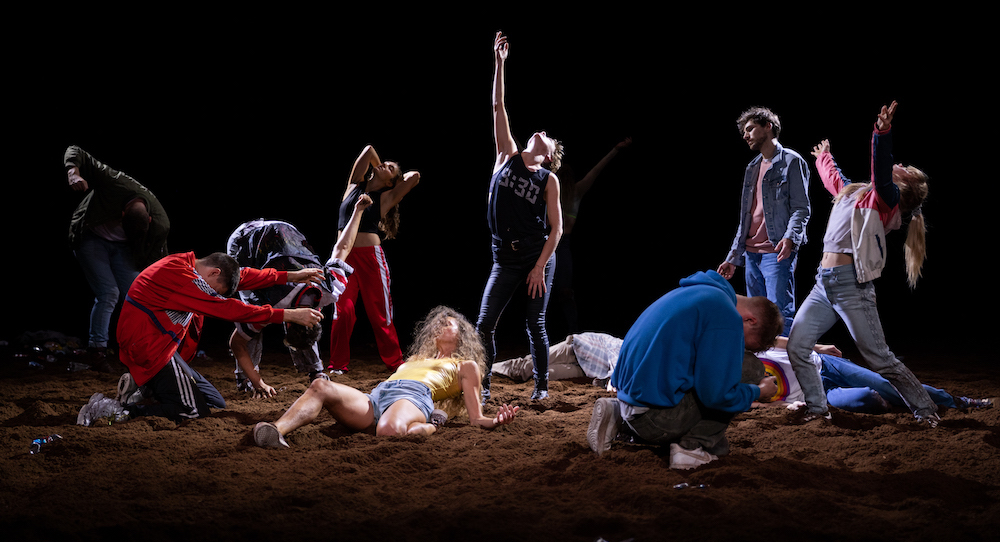Brooklyn Academy of Music, Brooklyn, NY.
October 13, 2022.
French choreographer Gisèle Vienne takes audiences on a slow motion journey through a rave in her 90-minute dance work, Crowd. The piece begins with a person wearing a hoodie and backpack entering from the upstage right corner in slow-mo, glittery sneakers shimmering as they glide across the dimly lit, textured stage. We soon realize that the floor is covered in dirt, scattered with trash.
One by one, more people enter, also in slow motion, from stage right in the faint light. Pedestrian interactions overtake the space as groups converge and dissipate; someone lights a cigarette, a few share drinks, two people hug as someone pours the contents of a water bottle onto another’s head. Is this a party? There is no direct connection between the movement and the upbeat dance music that pulses throughout the theater. Already the piece is a test of patience, but perhaps this challenge to audience members will later be rewarded?
Now, all the dancers are all frozen but one, and the sound shifts toward an ambient track. The movement is slow and sensitive. A woman in a water-stained green jacket holding a plastic bag is the first to move at normal speed, and she seems distressed. Another dancer is lifted at the center of the stage as the music builds, little real-time moments breaking through the slow motion as the track grows more ominous.
Then everything freezes once again. By now, the full cast is on stage, and all that’s moving are the lights. Even when the beat wins out again, the dancers remain frozen. Finally, a siren-like sound builds and the dancers start shifting, slightly off the beat in near unison. The movement is still reminiscent of a party as they mingle in the space, and feels improvised.
People are taking the top layers of their clothing off and dropping down to the floor, dirtying their under layers with some violence to the sound of a squeaky descending musical scale. It is clear that as a performer, you must enter an intense and specific state of mind to achieve the piece. A couple performing a sensual duet of micromovements, ticking into and out of each other’s negative spaces, stands out as a memorable moment.
Vignettes continue to fade into and out of existence, manipulations of “real life” performed in the midst of unreal circumstances. The musical transitions are also fades, and the dancers all appear to move at the “same” slow tempo even though some “characters” seem more important than others. Everyone remains on stage for the duration of the piece until their final exit, and at many points, I had the feeling that the piece would be better suited for an audience in the round or even an immersive setup that enables audience members to walk through the dancers and explore their arrangements three-dimensionally.
When viewed from the orchestra, however, shifting focus from individual dancers to the group as a whole in combination with the surrealistic scenarios the piece is composed of makes for a trippy effect. And the beat makes you want to move or at least want the dancers to move, but they won’t –– at least not in the way you want them to.
Things get progressively “dirtier” as the night goes on and a sudden, deafening beat visibly startles half the audience. Additional moments of real-time movement pop out of the endless slow motion as dirt, chips and water are thrown across the stage, although they still contain a certain degree of unnaturalness, a feeling of halting mid movement. Two men perform a part-flirty part-confrontational “conversation,” which is one of the most “dancey” parts of the piece. Someone screams, and then finally, for the first time, silence, which in the context of the piece is deafening.
By this point, several audience members have left the theater, having had their fill of undanced beats and minimal movement. I can’t shake the feeling of wanting “something” to happen even once I am certain that it won’t. Instead, it feels like nothing happens for several minutes and the audience’s antsiness is palpable. Then the beat returns once again, almost like a clock. Sounds of falling things rise in the background, and smoke starts coming out of some of the dancers’ costumes. Somehow, this was not the “something” I’d hoped for, and it doesn’t do much to create the sense of build that the piece never really achieves from the opening sequence. Instead, the show closes with the labored fulfillment of something predictable.
By Charly Santagado of Dance Informa.















